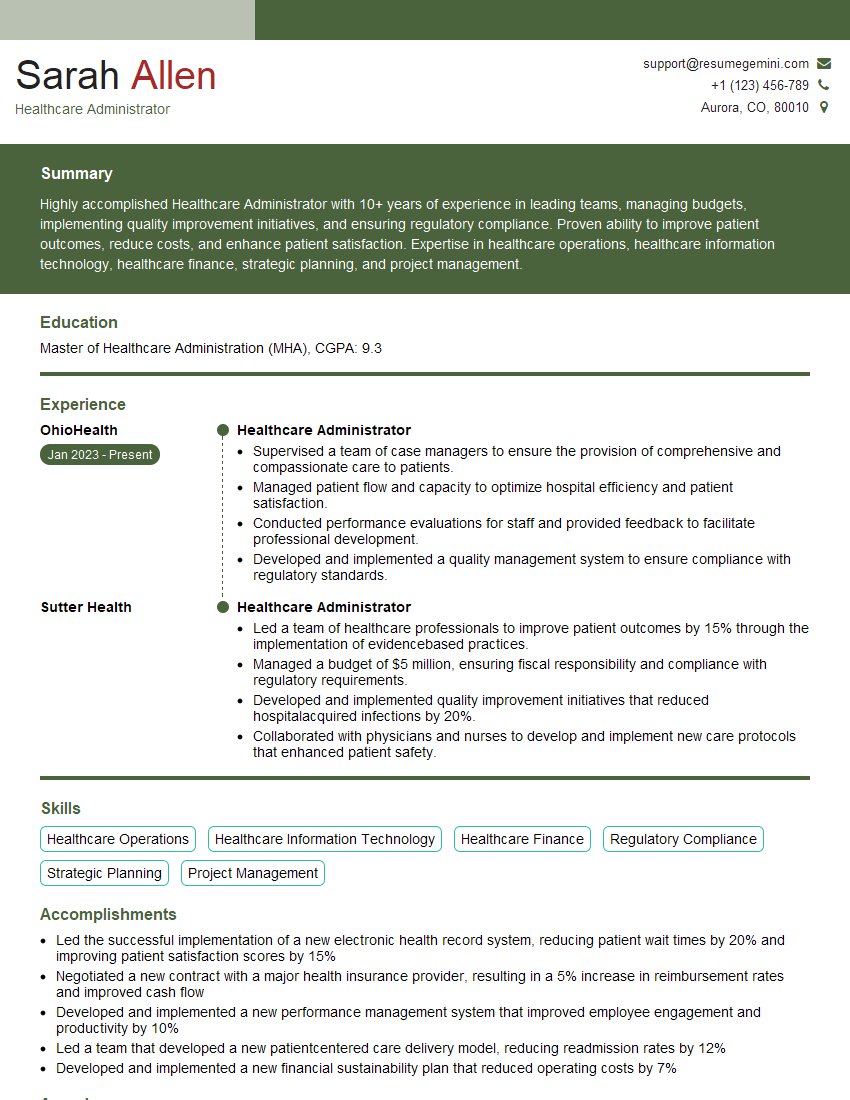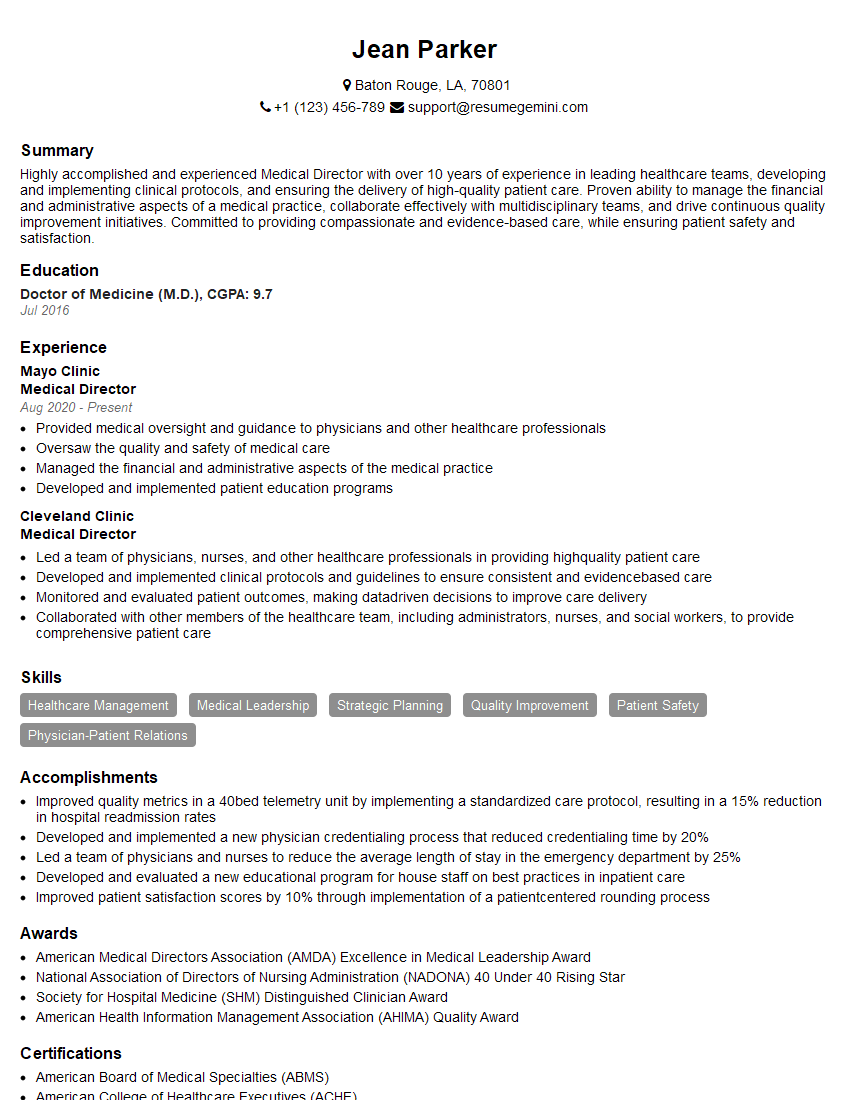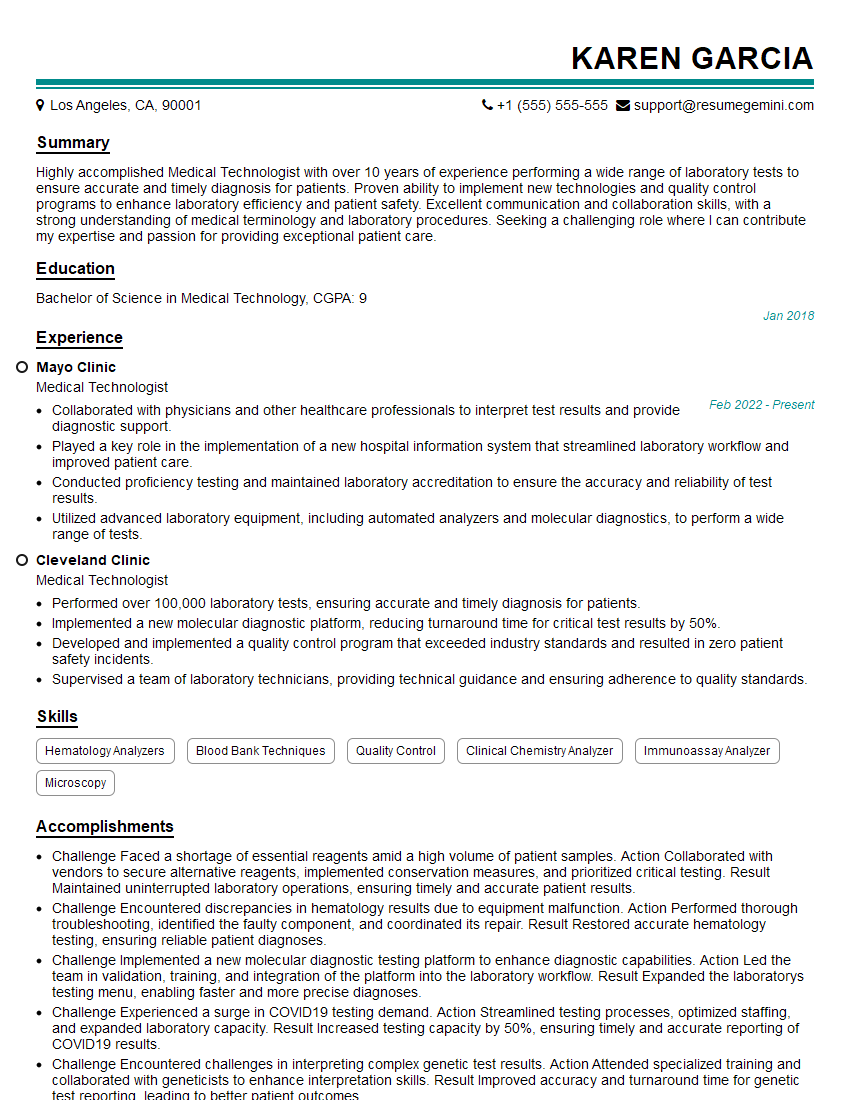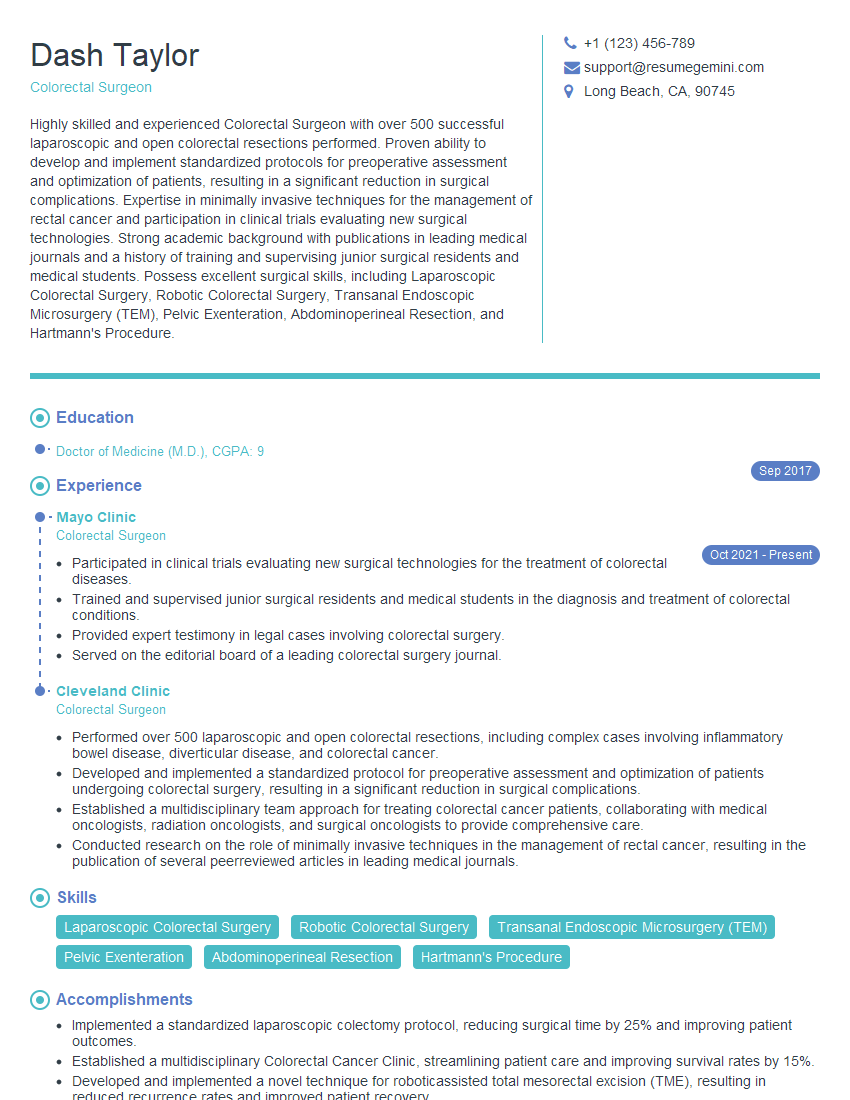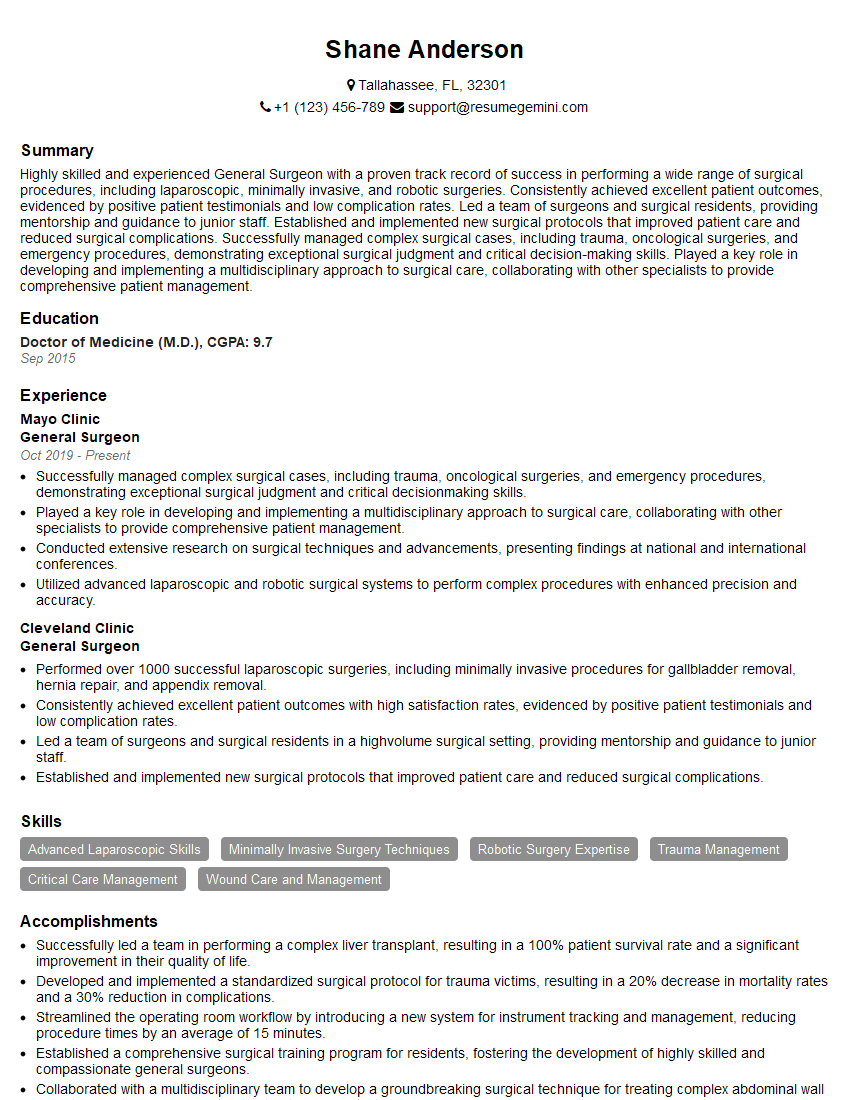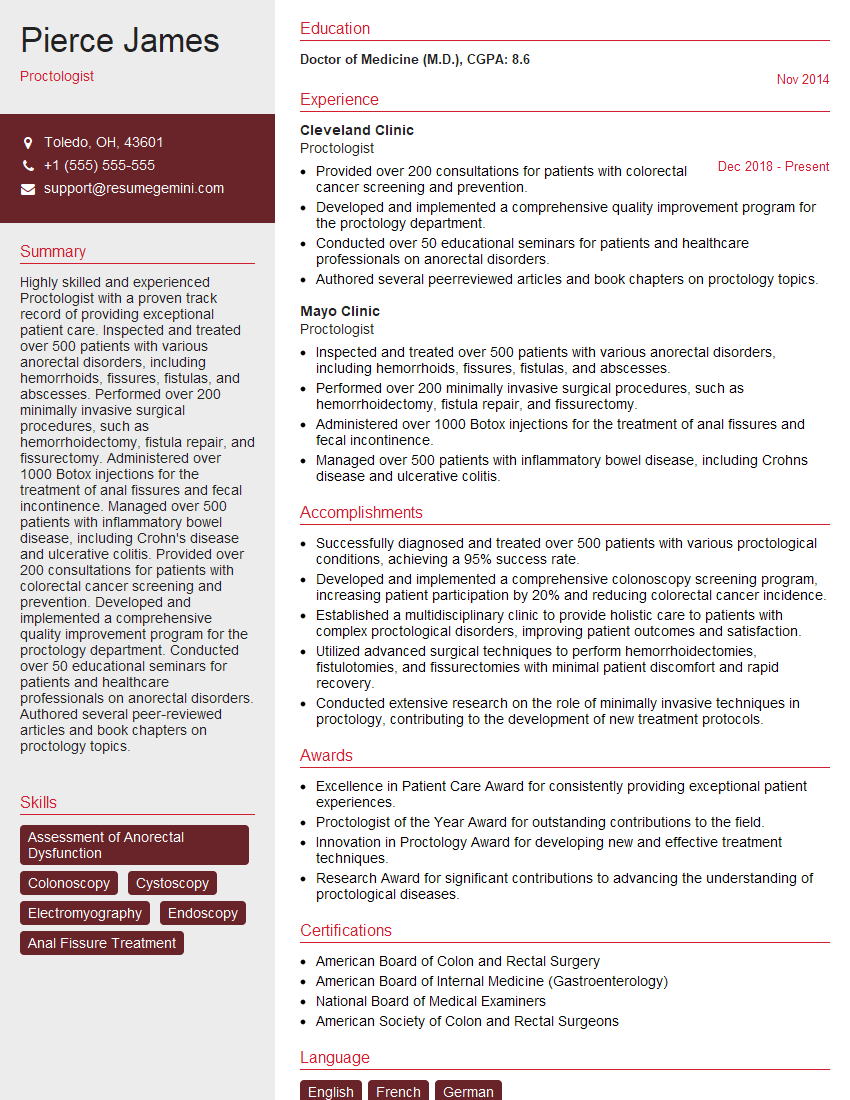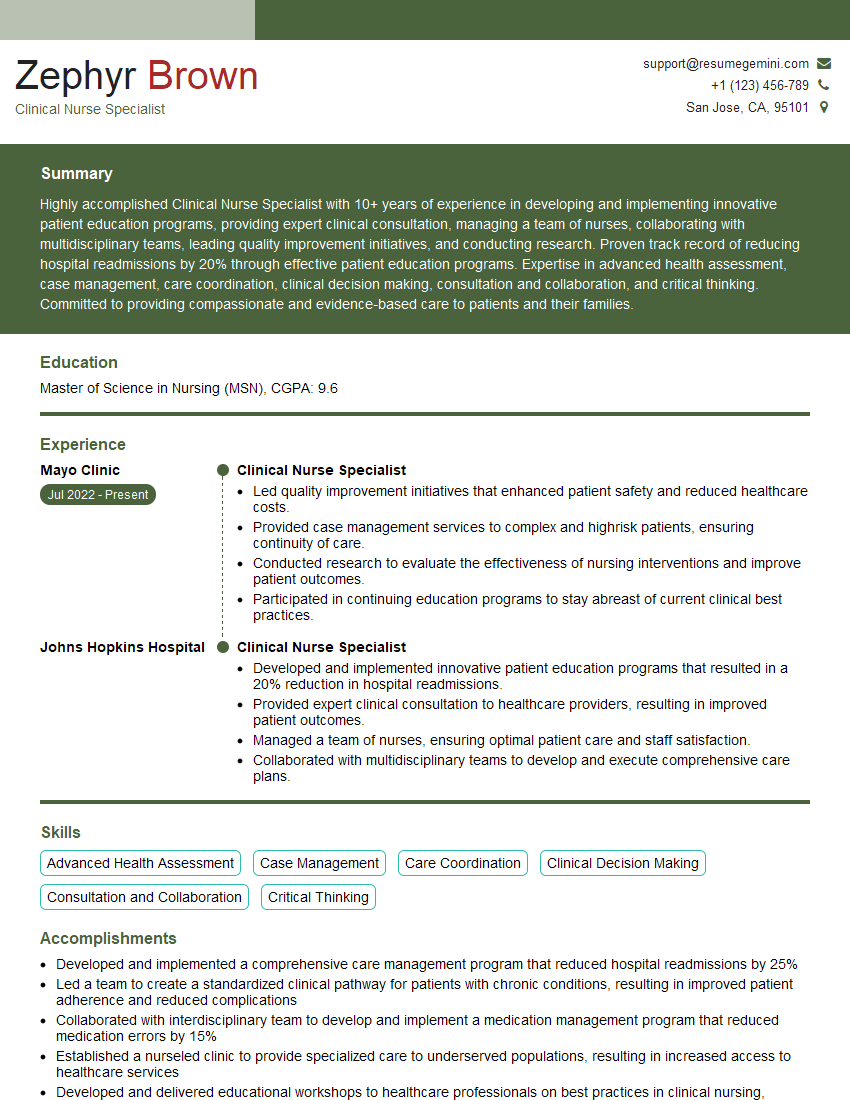Interviews are opportunities to demonstrate your expertise, and this guide is here to help you shine. Explore the essential Radiofrequency Ablation for Hemorrhoids interview questions that employers frequently ask, paired with strategies for crafting responses that set you apart from the competition.
Questions Asked in Radiofrequency Ablation for Hemorrhoids Interview
Q 1. Describe the mechanism of action of radiofrequency ablation in hemorrhoid treatment.
Radiofrequency ablation (RFA) for hemorrhoids works by using controlled heat to shrink the hemorrhoidal tissue. It doesn’t cut or remove the tissue like surgery, but rather causes collagen shrinkage and tissue necrosis. This leads to a reduction in hemorrhoidal volume and ultimately, symptom relief. Imagine it like gently tightening a loose balloon – the balloon (hemorrhoid) becomes smaller and less likely to bulge or bleed.
Specifically, the RFA device delivers radiofrequency energy to the submucosal tissue of the hemorrhoid. This heat energy denatures the collagen, causing the tissue to contract and eventually shrink. The process induces fibrosis and ultimately reduces the size and vascularity of the hemorrhoid, alleviating symptoms like bleeding, prolapse, and pain.
Q 2. What are the indications and contraindications for radiofrequency ablation of hemorrhoids?
RFA is indicated for patients with symptomatic internal hemorrhoids, primarily those experiencing bleeding or prolapse. It’s particularly suitable for grades II and III hemorrhoids (based on the Goligher classification). Patients with significant thrombosed hemorrhoids, severe perianal inflammation, or severe systemic illness are usually not good candidates.
- Indications: Bleeding, prolapse, pain, discomfort associated with internal hemorrhoids (grades II and III).
- Contraindications: Severe perianal infection, severe systemic illness, significant thrombosed hemorrhoids, pregnancy, patients with active bleeding diathesis or use of anticoagulants (requiring careful consideration and potentially adjusted management).
Q 3. Explain the different types of radiofrequency ablation devices used for hemorrhoids.
Several RFA devices are available, each with slight variations in design and energy delivery. Most commonly used are devices that utilize a bipolar or monopolar system. Bipolar systems use two electrodes within the probe that deliver the radiofrequency energy between them within the tissue. Monopolar systems use one electrode on the probe, which delivers energy into the tissue, with a dispersive electrode elsewhere on the body to complete the circuit. All devices share the goal of controlled heating within the hemorrhoidal tissue. The specifics of probe design and energy settings vary between manufacturers, but the fundamental mechanism remains the same. The choice of device often depends on surgeon preference and experience.
Q 4. How do you select appropriate patients for radiofrequency ablation?
Patient selection for RFA involves a careful evaluation. I begin with a thorough history and physical exam, including anoscopy or proctoscopy to visualize the hemorrhoids. I look for the presence of internal hemorrhoids (grades II and III are usually most suitable), the extent of prolapse, and the presence of any significant inflammation or infection. Patients with significant comorbidities or those on anticoagulation medications need careful consideration to assess the risk-benefit profile of the procedure.
I discuss the procedure in detail with the patient, outlining its benefits, risks, and alternatives. Informed consent is essential. I believe a personalized approach, understanding patient preferences and expectations is crucial to selecting the most appropriate treatment.
Q 5. What are the potential complications associated with radiofrequency ablation for hemorrhoids?
While generally safe, RFA can have potential complications. These are usually minor and self-limiting. However, it’s crucial to be aware of them. Potential complications include:
- Pain and discomfort (usually manageable with analgesics).
- Bleeding (rarely significant, usually stops spontaneously).
- Infection (requires prompt antibiotic therapy).
- Anal stenosis (narrowing of the anal canal, uncommon but potentially serious if severe).
- Recurrent hemorrhoids (may require repeat treatment).
The incidence of serious complications is relatively low with experienced practitioners.
Q 6. How do you manage complications arising from radiofrequency ablation of hemorrhoids?
Management of complications depends on the severity and nature of the issue. Post-operative pain is usually addressed with analgesics like acetaminophen or ibuprofen. Minor bleeding usually resolves spontaneously, but if significant, it might require cauterization or other interventions. Infection necessitates appropriate antibiotic therapy. Anal stenosis, if severe, may need surgical intervention such as anal dilatation or sphincterotomy. Recurrence is often managed with a repeat RFA procedure, potentially with modifications of the technique.
Post-procedure follow-up is crucial for monitoring healing and managing any complications that may arise. Regular check-ups allow for early identification and management of potential problems.
Q 7. Compare and contrast radiofrequency ablation with other hemorrhoid treatment modalities (e.g., banding, surgery).
RFA offers several advantages over other hemorrhoid treatments. Compared to rubber band ligation (banding), RFA generally causes less pain and is associated with a lower risk of severe complications such as infection or stenosis. While banding is often suitable for smaller hemorrhoids, RFA can treat larger ones. Surgical hemorrhoidectomy remains an option for severe cases, but it’s associated with a longer recovery time and potentially more significant pain and complications.
In comparison to surgery, RFA is less invasive, resulting in less pain, shorter recovery time, and a quicker return to normal activities. It’s usually performed as an outpatient procedure, with minimal downtime. However, it might not be appropriate for all stages of hemorrhoids and might have higher recurrence rates in some cases, compared to surgery.
The choice of treatment depends on the individual patient’s hemorrhoid grade, medical history, preferences, and expectations. A comprehensive assessment helps determine the most appropriate and effective approach.
Q 8. Describe the pre-operative and post-operative care for patients undergoing radiofrequency ablation.
Pre-operative care for radiofrequency ablation (RFA) of hemorrhoids is relatively straightforward. It typically involves a thorough medical history and physical examination to assess the patient’s overall health and the severity of their hemorrhoids. This includes evaluating for any contraindications to the procedure, such as bleeding disorders or severe heart conditions. Bowel preparation, often involving a clear liquid diet and laxatives for a day or two before the procedure, is crucial to ensure a clean colon and minimize the risk of infection. Patients are usually advised to stop taking blood-thinning medications temporarily, as directed by their physician. Post-operative care is also important for a smooth recovery. Patients are typically given post-operative instructions including advice on pain management, often involving over-the-counter analgesics. A high-fiber diet and increased fluid intake are recommended to prevent constipation. Patients should avoid straining during bowel movements. Regular follow-up appointments are scheduled to monitor healing and address any complications. The post-operative period typically involves a gradual return to normal activities.
Q 9. What are the patient selection criteria for radiofrequency ablation of hemorrhoids?
Patient selection for RFA is crucial for optimal outcomes. Ideal candidates are generally adults with second or third-degree hemorrhoids who haven’t responded to conservative treatments like dietary modifications, fiber supplements, and topical medications. Patients with significant medical comorbidities or bleeding disorders may not be suitable. RFA is not typically recommended for fourth-degree hemorrhoids (prolapsed and thrombosed hemorrhoids) or those with severe internal hemorrhoids that may require surgical intervention. A thorough examination is performed to assess the location, size, and severity of the hemorrhoids to ensure that RFA is appropriate. The procedure is not suitable for all patients, and the physician will discuss alternative options if necessary. It’s vital that patients fully understand the procedure, potential risks, and recovery expectations before proceeding.
Q 10. What are the advantages and disadvantages of radiofrequency ablation for hemorrhoids compared to surgical hemorrhoidectomy?
Compared to surgical hemorrhoidectomy, RFA offers several advantages. It’s minimally invasive, resulting in less pain, shorter recovery time, and minimal scarring. It’s often performed as an outpatient procedure, reducing hospital stay and costs. RFA also has a lower risk of complications such as bleeding and incontinence compared to traditional surgery. However, RFA may not be as effective for severe or very large hemorrhoids as surgery is sometimes needed. Also, recurrence rates might be slightly higher with RFA compared to surgical hemorrhoidectomy though it still offers a considerable improvement over the more traditional approach for many patients. The choice between RFA and hemorrhoidectomy depends on individual patient factors and the severity of the hemorrhoids. For example, a younger patient with smaller second-degree hemorrhoids might be a better candidate for RFA, while an older patient with large, symptomatic third- or fourth-degree hemorrhoids might benefit more from a surgical approach.
Q 11. What are the typical pain levels associated with radiofrequency ablation for hemorrhoids?
Pain levels associated with RFA are generally mild to moderate. Most patients describe the pain during the procedure as a mild discomfort or burning sensation. Post-operatively, discomfort is usually manageable with over-the-counter pain relievers. Many patients report that the pain after RFA is significantly less than that experienced after a hemorrhoidectomy. It’s important to note that individual pain tolerance varies, and some patients may experience more discomfort than others. Preemptive pain management strategies are often part of the procedure.
Q 12. How long is the typical recovery period after radiofrequency ablation?
The typical recovery period after RFA is significantly shorter than after a surgical hemorrhoidectomy. Most patients can return to their normal activities within a few days, although strenuous activity should be avoided for about a week or two. Complete healing can take several weeks, depending on individual factors and the size of the hemorrhoids treated. In many cases, return to work and many daily activities is quicker than traditional surgery allowing for a faster return to normal life.
Q 13. What are the long-term outcomes of radiofrequency ablation for hemorrhoids?
Long-term outcomes of RFA are generally favorable. Studies show high rates of symptom relief and patient satisfaction. However, recurrence of hemorrhoids is a possibility, although the long-term recurrence rate is comparatively lower than that observed with other minimally invasive options or conservative management. Regular follow-up appointments are essential to monitor for any recurrence or complications. A proper maintenance plan, including diet and lifestyle changes, will improve long-term results.
Q 14. Discuss the role of imaging in radiofrequency ablation of hemorrhoids.
Imaging plays a limited role in RFA of hemorrhoids. While advanced imaging techniques like endoscopy, anoscopy and proctoscopy are essential for diagnosing the presence, location, and severity of hemorrhoids, real-time imaging during RFA itself is generally not required. The procedure is usually performed under direct visualization using a anoscope. The radiofrequency energy is targeted precisely to the affected hemorrhoidal tissue. Thus, advanced imaging techniques play a more significant role in pre-operative assessment, rather than during the procedural process itself.
Q 15. Describe the different energy settings used in radiofrequency ablation.
Radiofrequency ablation (RFA) for hemorrhoids utilizes different energy settings to achieve controlled tissue destruction. The settings are primarily determined by the device used and the specific hemorrhoid’s size and location. It’s not a matter of choosing from a list of pre-set ‘high’ or ‘low’ options, but rather a nuanced approach tailored to each case. The goal is to generate enough heat to cause coagulation necrosis (tissue death) of the hemorrhoidal tissue, without causing excessive damage to surrounding healthy tissue.
Generally, parameters such as power (measured in Watts), application time (measured in seconds), and the impedance (resistance to electrical current) are adjusted. Higher power settings deliver more energy quickly, which might be suitable for larger hemorrhoids, whereas lower power settings, applied for longer durations, offer more precise control for smaller ones. The impedance reading helps monitor the energy delivery; high impedance can indicate poor contact between the electrode and the tissue, and adjustments may be necessary. The precise settings are constantly monitored and adjusted during the procedure based on real-time tissue response and impedance readings. Imagine it like sculpting with heat: you need to control the intensity and duration precisely to achieve the desired result.
Career Expert Tips:
- Ace those interviews! Prepare effectively by reviewing the Top 50 Most Common Interview Questions on ResumeGemini.
- Navigate your job search with confidence! Explore a wide range of Career Tips on ResumeGemini. Learn about common challenges and recommendations to overcome them.
- Craft the perfect resume! Master the Art of Resume Writing with ResumeGemini’s guide. Showcase your unique qualifications and achievements effectively.
- Don’t miss out on holiday savings! Build your dream resume with ResumeGemini’s ATS optimized templates.
Q 16. What are the safety considerations during radiofrequency ablation procedures?
Safety is paramount in RFA for hemorrhoids. Several considerations are crucial:
- Proper patient selection: RFA is not suitable for all patients. Those with significant bleeding disorders, active infections, or certain medical conditions may not be good candidates. A thorough pre-operative assessment is mandatory.
- Accurate electrode placement: Incorrect placement can lead to damage to surrounding healthy tissues, causing pain, bleeding, or other complications. Real-time visualization using ultrasound or anoscopy is often necessary for precise placement.
- Monitoring vital signs: Continuous monitoring of heart rate, blood pressure, and oxygen saturation is vital throughout the procedure to detect any adverse effects.
- Pain management: While RFA is generally well-tolerated, some patients experience discomfort. Adequate analgesia (pain relief) before, during, and after the procedure is essential.
- Potential for complications: Although rare, complications such as bleeding, infection, perforation, or nerve damage are possible. Patients must be informed about these potential risks before the procedure.
We mitigate these risks through careful patient selection, meticulous technique, close monitoring, and a comprehensive post-operative plan including pain management and follow-up.
Q 17. How do you manage bleeding during or after the procedure?
Bleeding is a potential complication of RFA, though typically minimal. Preoperative assessment identifying patients with coagulation disorders is crucial. During the procedure, careful technique minimizes bleeding by ensuring proper electrode placement and energy delivery. We usually apply direct pressure to the treatment site after the energy application. Post-procedure bleeding is rare; however, patients are advised to avoid strenuous activity and to monitor for any signs of excessive bleeding.
In the event of significant bleeding, interventions may include topical hemostatic agents (agents that stop bleeding) or, in rare cases, surgical intervention. Post-operative instructions to the patient emphasize careful attention to bowel habits (avoiding straining) and reporting any concerns immediately.
Q 18. How do you assess the effectiveness of radiofrequency ablation?
Assessment of RFA effectiveness involves a multi-pronged approach. Immediate post-procedure evaluation includes visual inspection to assess the treated tissue. Long-term evaluation relies heavily on patient-reported outcomes, including symptom improvement, reduction in bleeding, and improvement in quality of life. We typically schedule follow-up appointments at regular intervals to assess these factors.
Objective measures, such as anoscopy or colonoscopy in selected cases, can help confirm the extent of tissue destruction and healing. Patient questionnaires focusing on symptoms and satisfaction levels provide valuable data. Success is often defined by a significant reduction in hemorrhoidal symptoms and improved patient quality of life, and not necessarily by complete eradication of the hemorrhoidal tissue.
Q 19. What are the common patient questions and concerns regarding radiofrequency ablation?
Common patient questions and concerns revolve around pain levels, procedure duration, recovery time, effectiveness, and potential complications. Many patients are anxious about the procedure itself. Addressing these concerns openly and honestly is key to building trust and ensuring informed consent. Patients often want reassurance that the procedure will significantly improve their symptoms without causing excessive discomfort or long-term side effects. We always take the time to carefully answer each question and allay their concerns, often providing realistic expectations based on their specific situation.
Q 20. How would you explain the procedure to a patient?
Explaining the procedure to a patient involves using clear, simple language and avoiding medical jargon. I would describe RFA as a minimally invasive procedure that uses controlled heat to shrink hemorrhoids, relieving symptoms such as bleeding, pain, and itching. I would explain that the procedure is usually performed in an office setting under local anesthesia and takes only a short time.
I’d then explain the pre-procedure preparation, which includes a bowel preparation. I would also describe the post-procedure recovery, emphasizing that it involves minimal downtime and that patients can typically return to normal activities within a few days. I also emphasize that while rare, complications are possible and would explain them in detail. Finally, I would answer any and all questions the patient has and ensure they are comfortable proceeding.
Q 21. Describe your experience with different types of radiofrequency ablation devices.
My experience encompasses several types of radiofrequency ablation devices, each with its strengths and weaknesses. While the underlying principle remains the same—controlled tissue heating—the specifics of energy delivery, electrode design, and visualization capabilities vary. For example, some devices use a circular electrode for circumferential treatment, while others employ a linear electrode for targeted ablation.
Some devices incorporate ultrasound guidance for precise electrode placement, enhancing safety and accuracy. Advances in technology have also led to devices with improved energy delivery mechanisms, resulting in faster treatment times and reduced discomfort. My experience allows me to select the most appropriate device based on individual patient needs and the characteristics of the hemorrhoids.
Q 22. What is your experience with managing post-operative complications such as pain, bleeding, or infection?
Managing post-operative complications after radiofrequency ablation (RFA) for hemorrhoids is crucial for patient comfort and successful outcomes. The most common complications are pain, bleeding, and infection, each requiring a different approach.
Pain Management: Most patients experience mild to moderate discomfort, effectively managed with over-the-counter analgesics like acetaminophen or ibuprofen. In cases of severe pain, stronger prescription pain medication may be necessary. We also educate patients on the use of sitz baths and stool softeners to reduce strain and discomfort. For example, I recently had a patient who experienced significant pain despite preemptive analgesics. We adjusted his pain medication regimen and added a prescription-strength topical analgesic cream, providing immediate relief.
Bleeding Management: Minor bleeding is common and usually resolves spontaneously. However, significant bleeding requires close monitoring and may necessitate further intervention such as cauterization or, rarely, surgical intervention. Patient education on avoiding straining during bowel movements is vital. I had a case where a patient experienced more than expected bleeding; a quick examination revealed a small area of delayed hemostasis that was easily addressed with targeted cauterization.
Infection Management: Infection is rare but serious. Signs of infection (fever, increased pain, purulent discharge) necessitate immediate antibiotic treatment and close monitoring. Prophylactic antibiotics are not routinely used unless there’s a specific risk factor present. We emphasize meticulous wound hygiene and proper follow-up appointments to catch any potential infections early.
Q 23. What is your understanding of the latest research and advancements in radiofrequency ablation for hemorrhoids?
Research in RFA for hemorrhoids continues to focus on improving efficacy, reducing complications, and refining techniques. Advancements include:
Improved Device Technology: Newer devices offer more precise energy delivery and improved tissue coagulation, leading to better outcomes and less post-operative discomfort. For instance, some newer devices allow for real-time tissue monitoring during the procedure.
Minimally Invasive Techniques: The trend is towards less invasive approaches, often requiring less anesthesia and shorter recovery times. This includes refinement of techniques to target specific hemorrhoidal tissue more accurately.
Combination Therapies: Studies are exploring the combination of RFA with other minimally invasive techniques or medications to further enhance efficacy and address specific patient needs.
I regularly review the latest publications in peer-reviewed journals to stay abreast of these advancements and ensure I’m providing my patients with the best possible care.
Q 24. How would you handle a situation where a patient experiences severe pain after the procedure?
Severe post-operative pain after RFA is uncommon but warrants immediate attention. My approach involves a systematic evaluation:
Thorough Assessment: I would first conduct a detailed assessment of the patient, including a physical examination to rule out potential complications such as infection or hematoma.
Pain Management: I’d initiate or intensify pain management, which might include stronger analgesics, prescription-strength topical anesthetics, or even nerve blocks in severe cases. This could involve adjusting the type and dosage of medication, or exploring additional strategies like nerve blocks.
Addressing Underlying Causes: If the pain is not readily relieved, I would investigate possible underlying causes. This could involve imaging studies or a referral to a colorectal surgeon. For instance, if we suspect a hematoma, that would necessitate surgical intervention.
Patient Communication: Open communication with the patient is critical to manage their anxiety and expectations about pain relief.
Q 25. Describe your approach to patient education before, during and after the procedure.
Patient education is paramount to a successful RFA procedure. My approach is multi-faceted:
Pre-Procedure: I provide detailed information on the procedure, potential risks and benefits, and post-operative care. I answer all questions thoroughly and address any concerns the patient may have, emphasizing the importance of realistic expectations regarding recovery time. This includes providing detailed instructions on bowel preparation.
During Procedure: If conscious sedation is used, I make sure the patient is comfortable and informed about the progress of the procedure in a reassuring way. I check in regularly and ensure they are adequately sedated and pain-free.
Post-Procedure: I provide specific instructions on wound care, diet, activity level, pain management, and follow-up appointments. I give clear guidance on when to seek immediate medical attention. I also encourage patients to contact me if they have any questions or concerns after they leave the clinic. For instance, I supply each patient with a comprehensive handout summarizing all this information.
Q 26. How would you manage a patient with a history of bleeding disorders who needs radiofrequency ablation?
Managing a patient with bleeding disorders who needs RFA requires careful consideration and a multidisciplinary approach. A detailed review of the patient’s coagulation profile is essential. This may involve consulting with a hematologist to assess the risk of bleeding and determine appropriate management strategies. Depending on the severity of the bleeding disorder, we may need to adjust the procedure or even consider alternative treatment options. It is crucial to optimize the patient’s coagulation status before the procedure, potentially involving medication adjustments. In certain high-risk cases, the procedure might not be a suitable option, and other treatment choices will be explored.
Q 27. What are the ethical considerations related to performing radiofrequency ablation for hemorrhoids?
Ethical considerations in performing RFA for hemorrhoids center around informed consent, shared decision-making, and appropriate patient selection. It’s crucial to:
Obtain fully informed consent: Patients must be fully informed about the benefits, risks, and alternatives to RFA before making a decision. This includes discussing potential complications, limitations of the procedure, and the possibility of needing further treatment.
Engage in shared decision-making: The treatment plan should be tailored to the individual patient’s needs and preferences, weighing the benefits against the risks. It’s not simply a case of recommending the procedure without considering other possibilities.
Appropriate patient selection: RFA is not suitable for all patients with hemorrhoids. Careful selection ensures the procedure is appropriate for the specific patient’s condition and reduces unnecessary interventions. For example, patients with severe prolapse or severe inflammatory conditions might not be ideal candidates.
Maintain patient confidentiality: All patient information must be kept confidential and handled ethically according to professional guidelines and data protection regulations.
Q 28. What is your experience with using procedural sedation for radiofrequency ablation?
My experience with procedural sedation for RFA is extensive. I utilize conscious sedation frequently, typically with a combination of intravenous medications tailored to the patient’s needs and medical history. The goal is to provide comfort and reduce anxiety during the procedure while maintaining a level of responsiveness to allow for communication and assessment. A qualified anesthesiologist or appropriately trained nurse anesthetist is always present to monitor vital signs and ensure patient safety. This allows us to perform the procedure with comfort for the patient and with the necessary level of precision for optimal outcomes. Close monitoring ensures the level of sedation is carefully controlled and adjusted as needed to ensure patient comfort while maintaining safety.
Key Topics to Learn for Radiofrequency Ablation for Hemorrhoids Interview
- Procedure Overview: Understand the mechanism of radiofrequency ablation in treating hemorrhoids, including tissue coagulation and its effects on hemorrhoidal tissue.
- Patient Selection Criteria: Learn the criteria for selecting appropriate candidates for radiofrequency ablation, considering various factors such as hemorrhoid grade, patient health, and contraindications.
- Pre-operative Preparation: Familiarize yourself with the necessary steps involved in preparing a patient for the procedure, including bowel preparation and potential medication adjustments.
- Procedure Technique: Master the practical aspects of performing radiofrequency ablation, including equipment usage, insertion techniques, and monitoring vital signs.
- Post-operative Care: Understand the post-operative management of patients, including pain management, dietary recommendations, and follow-up care.
- Complications and Management: Be prepared to discuss potential complications associated with the procedure, their management, and preventive strategies.
- Comparison with Other Treatments: Understand the advantages and disadvantages of radiofrequency ablation compared to other hemorrhoid treatment methods (e.g., rubber band ligation, surgery).
- Technological Advancements: Stay updated on the latest advancements in radiofrequency ablation technology and their impact on clinical practice.
- Evidence-Based Practice: Understand the supporting clinical evidence and research behind the efficacy and safety of radiofrequency ablation for hemorrhoids.
- Ethical Considerations: Be familiar with the ethical considerations related to patient informed consent and appropriate treatment selection.
Next Steps
Mastering Radiofrequency Ablation for Hemorrhoids significantly enhances your value as a skilled healthcare professional, opening doors to advanced roles and greater career satisfaction. A well-crafted resume is crucial for showcasing your expertise and securing your ideal position. Creating an ATS-friendly resume is essential to navigate applicant tracking systems effectively. We strongly recommend using ResumeGemini to build a professional and impactful resume that highlights your skills and experience in Radiofrequency Ablation for Hemorrhoids. ResumeGemini provides examples of resumes tailored to this specific area, helping you create a compelling application that stands out from the competition. Invest time in crafting a strong resume – it’s your first impression and a key to unlocking your career potential.
Explore more articles
Users Rating of Our Blogs
Share Your Experience
We value your feedback! Please rate our content and share your thoughts (optional).
What Readers Say About Our Blog
This was kind of a unique content I found around the specialized skills. Very helpful questions and good detailed answers.
Very Helpful blog, thank you Interviewgemini team.
